Traveling, or the new concept we have of travel, goes far beyond visiting a place or moving from one site to another.
Now, traveling has become the best way to connect with and get to know different cultures, discover new stories, and above all, explore flavors and foods, which takes us straight to the heart of each destination.
Zaragoza, as the Aragonese capital, is faithful to this rule. To fully experience Zaragoza, it is necessary to immerse ourselves in its rich gastronomic landscape and thus, taste the most characteristic recipes and dishes of the capital.
Each recipe and each dish encapsulate part of the history and culture of the city and its people, blending traditions that date back to ancient times with contemporary styles that amaze and please everyone.
Are you going to miss it? Keep reading our blog and let yourself be captivated by such succulent content.
Discover the Flavors of Zaragoza’s Cuisine with Us
Whether your palate prefers sweet or savory, Zaragoza’s cuisine is designed to please all our visitors.
In this blog, we are going to give you all the hints you need to know about the typical dishes of Zaragoza that you must try and thus fully enjoy the essence of our capital.
Moreover, we will give you some interesting facts about the preparation of each of the recipes we discuss here, so you can get to know and decide to try them. Are you ready?
If you have just arrived in the city and are looking to immerse yourself in our culinary culture, stay tuned, as we are going to propose the ten most traditional and delicious dishes of Zaragoza.
Gastronomic Wealth: Discovering Our Culinary Offer in Zaragoza
Zaragoza is a city of great gastronomic richness, full of native products, ranging from the best meats with a designation of origin, such as Ternasco de Aragón, through fresh and seasonal vegetables from the Aragonese orchards, to the tastiest desserts like torrijas.
Over time, Zaragoza has become a true paradise for the most demanding palates, thanks to the wide culinary offer it provides.
In this post, we will help you discover, through the 10 most characteristic dishes of the city, the most emblematic flavors of the region.
A Cuisine Marked by Its Origin and History
The gastronomic offerings of Zaragoza are a faithful reflection of its geographical location and history.
Situated at the crossroads between the rural and the cosmopolitan, it has absorbed and incorporated the best of the culinary traditions of the peoples who have inhabited its lands and neighboring regions.
Thus, it has created a unique gastronomic identity that has managed to keep alive the efforts of its chefs and producers. Our menu ranges from hearty dishes that centuries ago were served in Zaragoza’s oldest bars, to innovative creations that seek to surprise the most contemporary diner.
In Zaragoza, flavors predominate, where the quality of the product and respect for tradition are the main protagonists.
Eating in Zaragoza has become, today, an essential opportunity to get to know Aragon, share a table, enjoy good company, and experience very tasty moments.
In short, whether you opt for more classic dishes or seek to surprise yourself with the latest culinary trends, Zaragoza is designed to offer you a complete, unique, and rewarding gastronomic experience during your stay.
Food in Zaragoza: The Result of a Cultural Crossroads
We are the result of our history.
From the fields to the table, Zaragoza offers a gastronomic experience that tells a story of the land and of the hands that worked each of the ingredients in its recipes.
From the care and attention of the artisans who tend the Aragonese orchards, where vegetables are later harvested to create exquisite dishes.
Moving through the rivers that cross the cities, surrounding the extensive fields where numerous lambs are raised, which will be the origin of one of the gastronomic and culinary offerings that is attracting the most attention in Spain for its quality.
Innovations in Traditional Aragonese Cuisine
Dishes like Ternasco de Aragón or Aragonese crumbs, with their long history, coexist and sit alongside new creations.
Local chefs often look to the old recipe book to recover and reinterpret ancient dishes of the Zaragozan tradition using the most innovative techniques and in the most creative way.
In this manner, the best traditional cuisine is maintained and projected into the future, capturing the attention of foodies and gastronomic critics around the world.
The influence of the cultures that have passed through Zaragoza throughout history can be tasted in its cuisine.
Romans, Arabs, Jews, and Christians have left their mark, contributing to the richness of flavors and culinary techniques.
Dishes like bacalao ajoarriero or sweets like turrón de guirlache are a fine example of how the coexistence of cultures enriches the Zaragozan table.
Events in Zaragoza: A Way to Enjoy Gastronomy
In Zaragoza, gastronomy also serves as a reason for celebration in the form of festivals and culinary events, where both locals and visitors can taste and discover the variety of its cuisine.
It’s always “a good time” to immerse oneself in the gastronomic culture of Zaragoza, through wine and cheese tastings from the region, cooking workshops, and gastronomic tours that take us from the most traditional markets to the most innovative establishments.
Zaragozan Cuisine: A Sensory Journey Through the Flavors of the Region
In conclusion, Zaragozan gastronomy is a sensory journey that intertwines history, culture, and a love for good food, where each bite is a tribute to the Aragonese land, an encounter with tradition, and a nod to the innovation of our Aragonese recipe book.
Zaragoza becomes an essential destination for culinary enthusiasts and promises an unforgettable experience that captivates and satisfies all palates.
Essential Dishes of Zaragozan Cuisine
Gastronomy in Aragon, and specifically in Zaragoza, boasts a rich and diverse recipe book that includes mythical dishes that bring you closer to the city with every bite.
While many dishes embody the unique characteristics of the locale, here we share some of the most significant ones that will help you enjoy everything we’ve discussed here.
Enjoying an Authentic Dish of Aragonese crumbs with Fried Egg

Aragonese crumbs are one of the crown jewels of Aragonese cuisine. A dish that tells a story, the story of a people, their culture, their ingenuity, and their love for well-crafted food.
Indeed, this dish, traditionally linked to the life of Aragonese shepherds and transhumant herders, who, out of the need to make the most of the few resources they had, created a recipe simple in ingredients but rich in flavor and tradition, has been preserved to this day.
Preparation of Aragonese crumbs, a Delicacy from Zaragoza
Primarily made with stale bread, which is crumbled and slowly fried in lamb fat or bacon, Aragonese crumbs are a perfect example of how resourceful cooking can lead to dishes with exceptional flavor.
The addition of garlic and, sometimes, peppers and chorizo, and quintessentially grapes, gives the crumbs a complexity of flavors that makes them an ideal meal for the cold winter days of Aragon.
The culmination of this dish comes with a fried egg on top, whose yolk, when broken, mixes with the crumbs, creating a combination of textures and flavors that is simply irresistible.
This element not only adds richness to the dish but also creates a visual and taste contrast that elevates the crumbs eating experience to another level.
Serving crumbs is Also an Art
Not only that, but placing the crumbs in the oven might seem like an unnecessary step for a dish that, in all appearances, is already fully prepared. However, it gives the bread an incredible texture and a greater ability to absorb all the flavors of the recipe.
Finally, serving Aragonese crumbs is a complete ritual in itself. Tradition dictates that the dish should be prepared in a large frying pan or clay pot that is then brought to the table, fostering a sense of community and togetherness.
A Dish Laden with Meaning and Tradition in Zaragoza
It’s not just a meal; eating crumbs in Zaragoza becomes a celebration of Aragonese rural life, a way to connect with the roots and history of the region.
Aragonese crumbs, with their simplicity and depth, offer a lesson on how gastronomy can mirror the culture and geography of a place.
Through this dish, Zaragoza invites both locals and visitors to discover its identity, to share a moment of unity, and to enjoy the authentic flavors of its land.
For all these reasons, crumbs with fried egg are not just a mandatory Zaragozan meal for the visitor; they are an open door to the very essence of Aragon, a dish humble in its conception but majestic in its flavor and meaning.
Roasted Ternasco de Aragón with Potatoes, an Essential Delight in Zaragozan Restaurants
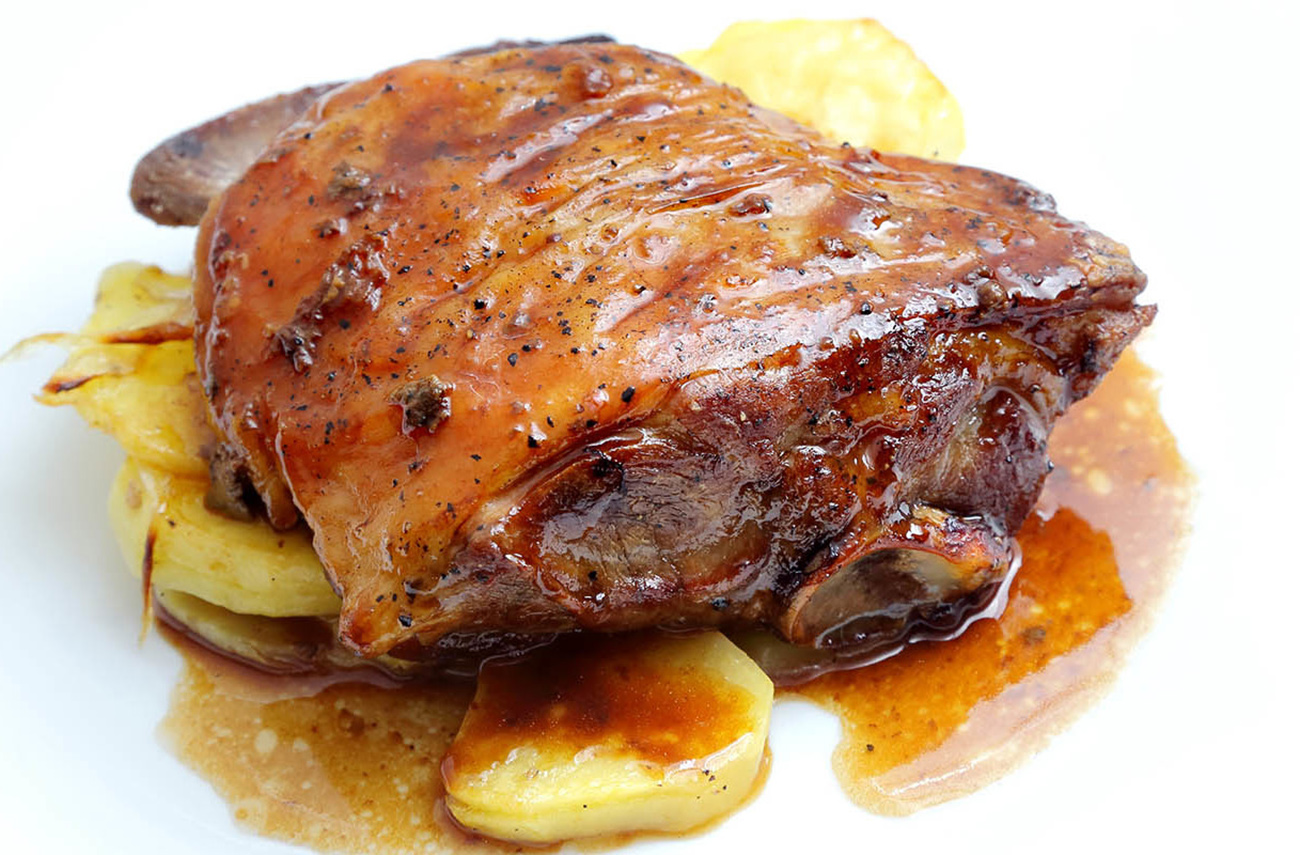
Ternasco de Aragón is much more than a typical dish; it’s a true institution in the gastronomy of this Spanish region, an emblem of its culture and culinary traditions.
This dish focuses on the tender and juicy meat of young lamb, specifically animals that do not exceed 90 days of age, ensuring a soft texture and delicate flavor, distinctive of this main ingredient.
Preparation of the Ternasco Dish in Zaragoza
Preparing ternasco is not complicated, but it requires attention and care to respect the quality of the meat. The most used and traditional method is oven-roasting, accompanied by potatoes.
The potatoes, cut into slices or pieces, are slowly cooked in the same dish as the ternasco, absorbing the juices and flavors of the meat, resulting in a perfect accompaniment, soft on the inside and crispy on the outside.
To begin, the ternasco is marinated with garlic, salt, pepper, and often, aromatic herbs from the region, such as rosemary or thyme, which perfectly complement the flavor of the meat.
Then, it’s placed in the oven, preheated to a temperature that allows slow and even cooking, ensuring that the meat remains tender and juicy on the inside, with a golden and crispy outer skin.
The potatoes, placed around the ternasco, are cooked in the same tray, thus taking advantage of the juices released by the meat during cooking.
History of Ternasco de Aragón, The Origin of an Emblem
Roasted Ternasco de Aragón with potatoes is not only a delight for the palate thanks to its rich and complex flavors, but it also has historical significance and keeps alive the Aragonese traditions.
This dish encapsulates the importance of sheep farming, an activity that has been practiced for centuries and is part of the region’s economy.
Zaragoza, The Cradle of Ternasco de Aragón
Eating roasted Ternasco de Aragón with potatoes is not merely tasting a delicious meal; it is also participating in a tradition that has been passed down from parents to children.
Every bite is a tribute to the land, its shepherds, and the gastronomic richness of Aragón.
Therefore, enjoying this Zaragozan meal becomes one of the must-visit stops for any traveler who wants to immerse themselves in the authentic Aragonese cuisine and a delicacy that is pure flavor, quality, and simplicity.
Bacalao Ajoarriero: From Geographical Isolation to a Zaragozan Delicacy
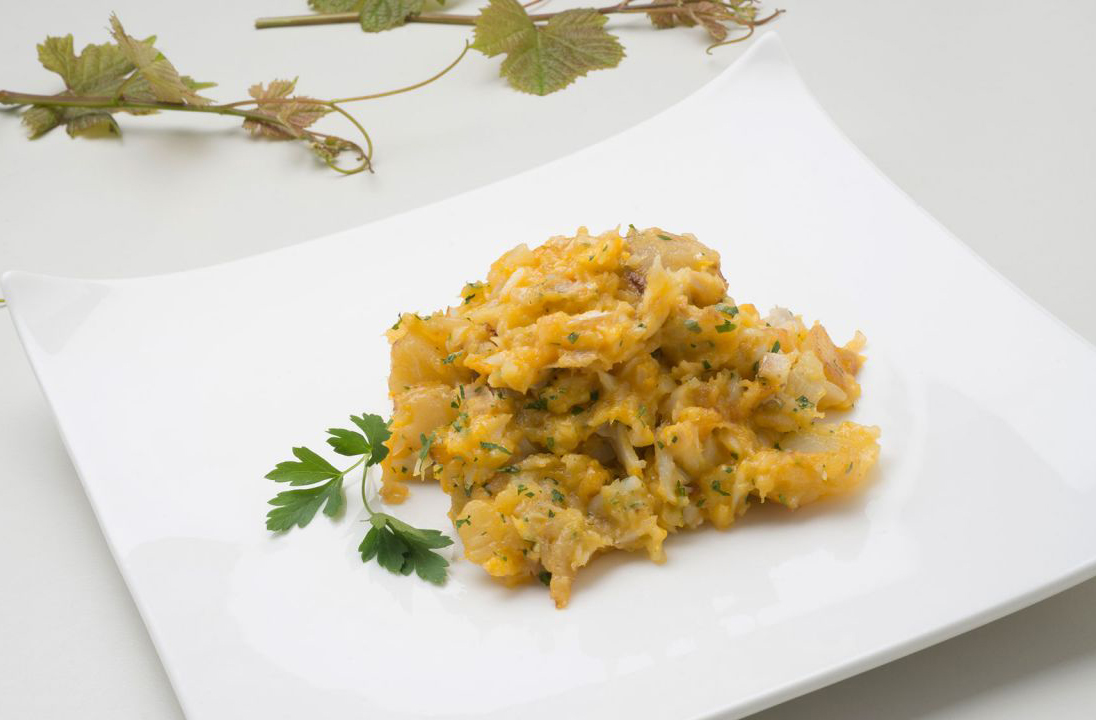
For a long time, Holy Week in Zaragoza has been synonymous with bacalao ajoarriero.
A recipe that dates back to ancient times and that emerged as a response to the need to preserve fish in an inland region like Zaragoza.
Over time, this recipe has been perfected through the incorporation of local products.
A dish that arose from necessity has today become a delicacy.
The shredding and desalting of the cod, its cooking on rosemary fires, its final baking in the oven, and its mix with stewed potatoes, tomato, garlic, oil, peppers, asparagus, eggs, give this dish its homemade and special touch.
Bacalao ajoarriero from Zaragoza is tangible proof that recipes are born out of necessity and can end up being a fundamental dish on our Zaragozan menus.
Preparation of a Unique Dish: Bacalao Ajoarriero
The preparation of bacalao ajoarriero is an art that reflects the wisdom of generations of Aragonese cooks.
It begins with the careful desalination of the cod, a process that requires patience and precision to ensure that the fish maintains an optimal texture and flavor.
Then, the cod is cooked for several hours in a pot with thinly sliced potatoes, chopped garlic, and, in some areas, also peppers, a mixture that is stirred until it reaches a soft and well-integrated stew, evoking the most authentic tastes.
Before serving, an egg is added to the stew and vigorously beaten, which binds all the components and adds creaminess to the whole.
Innovation of Bacalao Ajoarriero
The dish of ajoarriero means more than a combination of ingredients. It’s an example of the gift of adaptation and reinvention of Zaragozan cuisine.
Throughout the centuries, bacalao ajoarriero has remained true to its origins but has been incorporating innovations: from a base of nuts to a touch of local black truffle. Highlighting the versatility and context of Zaragozan cuisine.
Diving into a dish of bacalao ajoarriero in Zaragoza is to dive into the history of this land. It’s to connect with the stories of the fishermen who brought it from the sea in the mid-16th century, the chefs who have left their mark on each dish, the families who have prepared it time and again, and the Zaragozans who more than four hundred years ago turned it into one of the symbols of their gastronomic culture.
Enjoying bacalao ajoarriero is, without a doubt, a delicious invitation to explore the identity of Zaragoza through its most authentic flavors, its deepest traditions, and ultimately, to set the table on the banks of the Ebro in one of the most special corners of Spanish cuisine.
Bacalao ajoarriero is, therefore, a mandatory stop on the culinary itinerary of any visitor who wants to experience the essence of Zaragoza at their table.
Enjoy an Authentic Vegetable Stew in Zaragoza
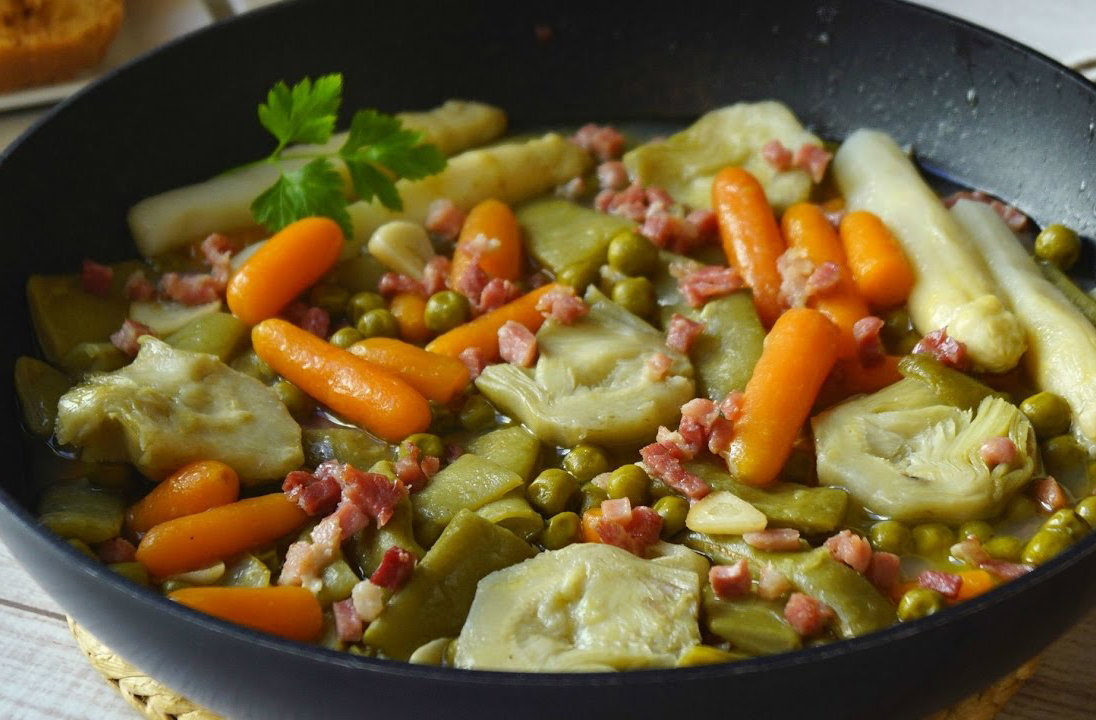
Vegetable stews are part of the DNA of the culinary tradition of Aragon, a region proud of its gardens and the abundance and diversity of its agricultural products.
This stew is a tribute to the land, a celebration of the harvest that flaunts the splendor of the Aragonese orchard and gathers the best in a single pot.
The Foundation of the Authentic Stew: Seasonal Vegetables
To the mix of vegetables, which varies from one season to another, egg is added, in the form of an omelet or sometimes scrambled, and pieces of ham or white bacon. All this contributes depth and a subtle counterpoint of flavor that enhances the final result.
Preparing an authentic Aragonese vegetable stew is embarking on a journey of flavors that begins by selecting the freshest and highest quality ingredients.
From tender artichokes and crunchy green beans to soft zucchinis and juicy tomatoes, each vegetable brings its texture and characteristic flavor to the dish.
The key to a good stew lies in the balance and harmony among all these elements, slowly cooked so that they merge into a rich and complex taste experience.
The Egg, an Addition to Zaragozan Stews
The incorporation of egg, beaten and added at the end of cooking, acts as a binder that smooths and unites the flavors. Pieces of ham or white bacon infuse the stew with a subtlety that enriches the dish’s taste profile.
This detail not only provides a contrast of textures but also pays homage to Aragonese culinary tradition, where the utilization of resources and the combination of local ingredients with pork products are common practices, as seen in the case of Aragonese crumbs.
The Zaragozan Stew: A Natural Balance of Garden Vegetables
Beyond its delicious taste, this dish speaks to Aragon’s connection with its natural surroundings, its fields, its respect for the cycle of the seasons, the importance of sustainability, and responsible consumption.
Served hot, a vegetable stew not only serves to warm the body on colder days but also nourishes the soul, reminding us of the value of simple things and of sharing a meal made with love.
Therefore, enjoying an authentic Aragonese vegetable stew is much more than enjoying a delicious meal; it’s an invitation to appreciate the richness of local gastronomy, to value the freshness and quality of the products that the Aragonese garden continues to bring to the table, and to celebrate the culinary traditions that make Aragonese cuisine one of the richest and most varied in all of Spanish geography.
Enjoy Our Chicken chilindrón, a Culinary Gem Originating from Zaragoza
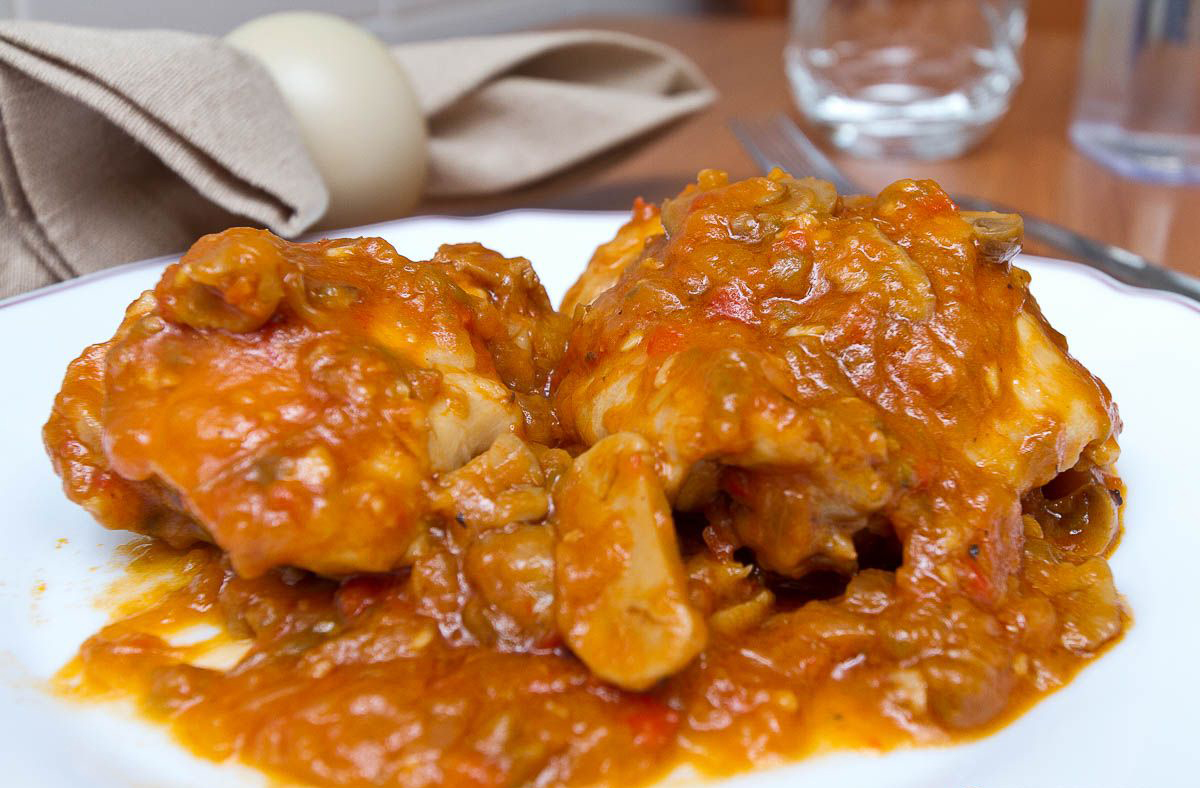
Chicken chilindrón is not just a dish; it is a genuine representation of Aragonese cuisine that incorporates the tradition and flavor of the region in every bite.
This specialty, which holds a privileged place in the Aragonese recipe book, is known for its rich and colorful Chilindrón sauce. Are you familiar with it?
This perfect blend of peppers, onions, tomatoes, and ham creates a mixture of flavors that accentuates the soft and juicy taste of the chicken.
However, it requires preparation and selection to fuse the ingredients and achieve the perfect balance this dish boasts.
The Chilindrón Sauce: A Unique Addition to This Dish
The Chilindrón sauce is based on a mixture of slowly poached vegetables enriched with ham, accompanying every piece of chicken so that all the flavors and textures cook together, and the final dish achieves a smooth consistency.
This dish is a testament to how Aragonese cuisine uses the products of its land to create unforgettable dishes with an irresistible historical charge.
The centerpiece of family celebrations and festivals, Chicken chilindrón
is an emblematic example of generosity and flavor in Zaragoza.
Borage with Potatoes, the Quintessential Zaragozan Dish
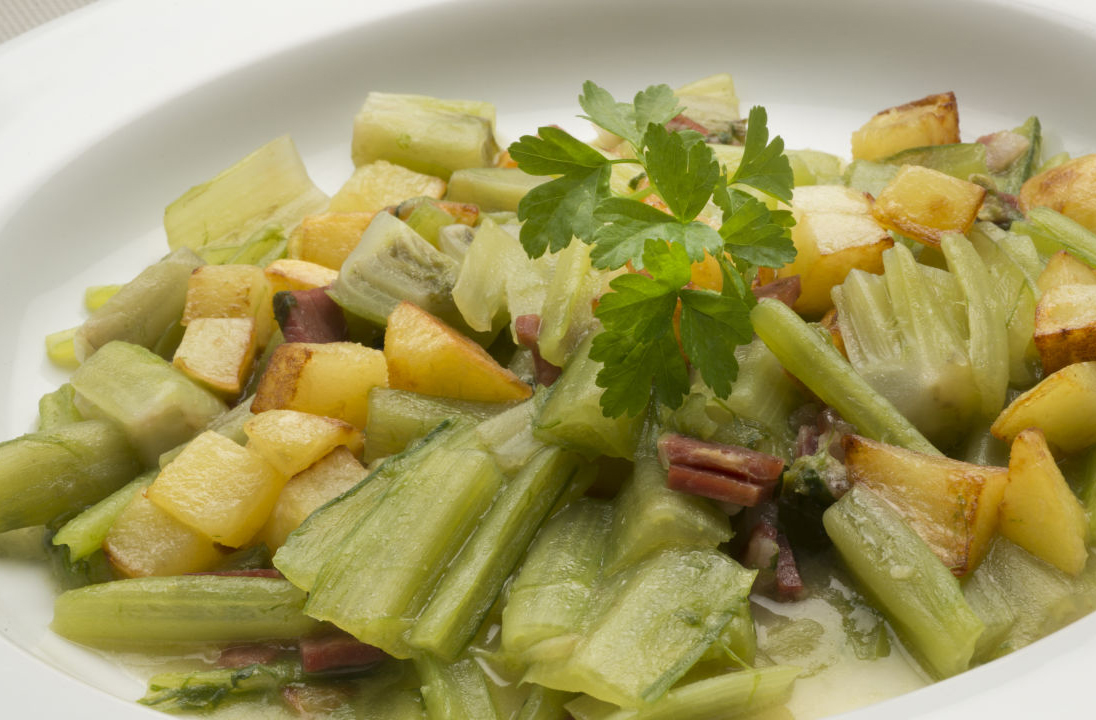
Although many vegetables are grown and enjoyed in Aragon, borage stands out as the undisputed queen of the Aragonese vegetable kingdom.
Not only for its delicate flavor and velvety texture but also for its richness in nutrients that have earned it worldwide recognition.
Cooked together with potatoes, their combination in this dish is an expression of the simplicity and richness of the Aragonese land.
Borage, cooked until it reaches the perfect texture point along with potatoes, embodies the essence of resourceful cooking, where fresh, quality raw materials reign supreme.
Borage with potatoes is yet another example of Zaragoza’s commitment to sustainability and the natural crop cycle of the garden.
For their simplicity, authenticity, and flavor, they are also the favorite bite of Zaragozans who do not hesitate to offer them to visitors so they can experience this beloved part of the Aragonese diet.
Borage with potatoes is more than a dish; it’s an experience that binds those who taste it to the land and customs of Zaragoza.
Chicken chilindrón and borage with potatoes are two typical dishes from Zaragoza that invite you to dive into the authentic flavors of Aragon, rich in their essence and deeply rooted in tradition. An indispensable appointment for anyone who wants to delve into the city’s gastronomic culture and firsthand feel the passion and dedication to its cuisine.
Desserts in Zaragoza: Exploring the Sweet Flavor of the City
The Aragonese capital boasts traditional sweets that complete the tasting of its rich gastronomic heritage, putting the finishing touch on any meal or mid-afternoon coffee.
These sweets not only delight the palate with unique flavors and diverse textures but also tell a piece of the city’s history and customs.
Want to know them?
The Pastry Art in Aragon
From the crunchy and aromatic guirlache nougat with toasted and caramelized almonds wrapped between sheets of baked caramel and a touch of anise to theFruits of Aragon.
These small candied fruits covered in sweet, dark chocolate turn them into little gems. Each of these sweets is a testament to the Aragonese pastry art.
The rice pudding, slowly cooked until it reaches a creamy consistency and topped with a bit of cinnamon, is an emblematic homemade dessert for many people. This dessert evokes childhood memories and moments shared with the family.
The peach with wine, on the other hand, is an extraordinary taste experience that combines the natural sweetness of peaches grown in the prosperous lands of Aragon with the richness of a good local red wine, resulting in a dessert that is a true culinary masterpiece and a celebration of regional products.
These sweets, with all their nuances and flavors, pay homage to the city’s love and dedication to pastry. A love that will continue recreating recipes passed down from generation to generation while exploring new, smarter, and tastier ways to present them in a modern form for the enjoyment of the most demanding palates.
In this sense, enjoying any of the incredible traditional sweets of Zaragoza, no matter which one, is a feast of sweetness, as well as a celebration of the region’s culture and traditions. Furthermore, it has become a recommended stop for travelers interested in the sweet flavor of life in the Aragonese capital.
Rice Pudding as a Typical Dessert of the Spanish Region of Aragon

Although rice pudding is a well-known and appreciated dessert in many parts of Spain, its special place in Aragon makes it a traditional and local dessert.
Created from the simplest yet richest ingredients, rice pudding has become asymbol of Aragon’s homemade cuisine.
Its particular creaminess and the way it immediately evokes a sense of home make it an essential sweet in Zaragozan kitchens.
This dessert boasts the region’s fresh milk products combined with the selection of rice grains and sugar plus a touch of cinnamon.
Preparation of Rice Pudding in Zaragoza
The preparation of rice pudding in Aragon is wrapped in care and attention, a true representation of the love for the land and the gastronomic legacy.
The milk, coming from local farms, is the star ingredient of this dessert, and its quality is essential to achieve the soft and enveloping texture that characterizes Aragonese rice pudding.
The rice, cooked slowly in this milk until it reaches the exact point of cooking, gives us a dessert that is both simple and winning.
A dessert that is, at the same time, a tribute to good practice and sustainable doing. The enjoyment of each spoonful of rice pudding contains a subtle reminder of how today agricultural and livestock production remains so important in the Aragonese territory.
A dish that also tastes like gathering. Just like the workday in the field, its sweetness is shared. It is no wonder, therefore, that in this territory, it is common to find it in the family recipe book or as the queen of the local festivals.
Rice Pudding: A Dessert with the Flavor of Home
In summary, beyond being a delicious dessert, rice pudding in Aragon is an expression of cultural connection where the ancient and modern worlds meet.
Every time it is cooked and shared, the bonds between the land and generations are strengthened, keeping the region’s culinary heritage intact.
A reminder that it’s important to take a pause and enjoy simple pleasures. It’s a dessert that shows us the vital role that traditions play in contemporary life.
Aragonese rice pudding is not just a sweet treat to delight the palate; it’s a feast for thought, urging reflection on the true roots of the food we consume, and why it’s worth preserving ancient recipes in a world increasingly built on the culture of others instead of our own.
Rice pudding is the sweet witness to how Aragon has always been committed to the land.
To taste it is to sip, in bittersweet sips, the history and culture of Aragon, enjoying an assault on reason made pleasure.
A pleasure in which, perhaps, in its simplicity, we might find the secret of “the Aragonese.”
Guirlache Nougat: A Sweet Symbol of Aragonese Tradition
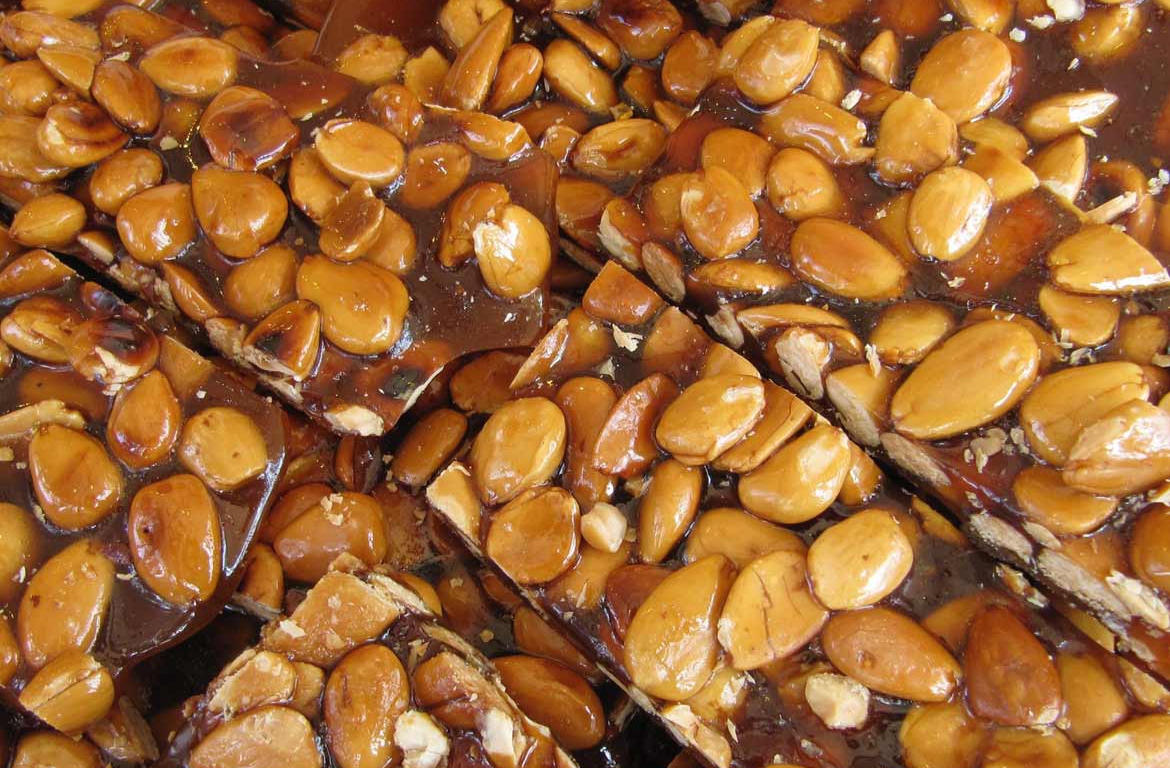
Guirlache nougat is the product of craftsmanship passed down from parents to children, a know-how that makes it a treat for the palate of both adults and children.
Its unmistakable crunchy texture results from mastering the exact point of caramel, in its precise boiling, which gives the consistency to envelop the almond while keeping it crunchy.
Precision, fortune, and patience that will guarantee the experience of the final success and attest to centuries of commitment to quality and excellence in the work of Aragon’s master pastry chefs.
The Crispiest Delicacy
Guirlache nougat is not just “one more” of the exquisite varieties of Spanish pastry; it is the sweet testimony of how history and Aragonese culture have managed to infuse essence into one of its many table delicacies. Thanks to the unforgettable mark left by the union of cultures that, through the centuries, have woven Aragon.
Guirlache nougat tempts alongside the likes of coconut, coffee, egg yolk, cherry, and candied fruit nougats, as well as truffle nougats.
Its Marcona almonds – the highest quality and flavor – intensely so; its caramel, golden as the gold of Monegros; the aroma of its anise… are the “work” of the masters of traditional Aragonese pastry.
Guirlache: A Sweet Among Cultures
Guirlache is much more than an almond treat; it is the tasty celebration of the fruits from the overflowing Aragonese garden and centuries of tradition forged with artisan mastery.
The Marcona almonds are one of the jewels of the land’s agriculture. The touch of anise, in addition to giving its subtle aroma with memories of Arab preferences brought to the Iberian Peninsula by the ancient Romans, adds the essence of so many enriching mixtures in the culinary history of the Aragonese.
Tasting Guirlache nougat is to travel through time and space, to connect with the history of Aragon and with the expert hands that, with dedication and love for their craft, continue to make this sweet following ancient recipes.
It is, in each bite, to discover the richness of flavors and texture that make this nougat an unforgettable experience.
For all these reasons, Guirlache nougat is a must-have on any visit to Zaragoza, especially during festivals and celebrations, where it becomes a protagonist at tables, sharing and spreading pride for the Aragonese gastronomic heritage.
This dessert invites locals and visitors to dive into the sweetness of Aragon, enjoying a piece of its history and tradition in every piece of this exceptional sweet.
Fruits of Aragon: Candied Delights at the Heart of Tradition

Fruits of Aragon are not just a simple dessert, but a vivid testimony to the richness and creativity of Aragonese gastronomy.
This delight not only combines the natural sweetness of candied fruits with the pronounced taste and finesse of dark chocolate but also upholds a tradition that has been passed from generation to generation, becoming a true regional emblem and a genuine treat for the palates of Zaragozans and tourists alike.
The making of Fruits of Aragon is an art that intertwines precision, patience, and respect for the ingredients.
Each fruit is selected for its quality and freshness and is candied with care, which involves a delicate process of slowly cooking the fruit in syrup, so the fruit acquires an infinitely softer sweetness, without sacrificing its essence or original flavor.
Thanks to this meticulous method, it is possible to enjoy the fruits out of season.
Fruits of Aragon: A Very Local Dessert
Once ready, the candied fruits are dipped into a bath of high-quality dark chocolate, resulting in a perfect indulgence of flavors and textures: the sweetness of the fruit and the distinguished bitterness of the chocolate, together in an exquisite bite that continues to seduce and surprise.
Beyond their undeniable delight, the Fruits of Aragon also stand as a testament to the region’s culinary ingenuity in continuing to innovate within the richness of tradition.
This dessert tells the story of Aragon, reminding us of the importance of food preservation techniques that allowed our ancestors to save the flavor of fruits throughout the year, even in winter.
The Most Emblematic Sweet of the City of Zaragoza
Fruits of Aragon are much more than a dessert: they are an emblem of Aragonese identity, a celebration of seasonality and the abundance of the land, and a reminder that the kitchen holds the power to make history, pure invention.
They are our proposal in the form of a delicacy to connect with Aragonese culture, a delicious bite of souvenir that invites to recompose its history with every bite.
A visit to Zaragoza by any gastronomy lover would not be complete without a tasting of Fruits of Aragon. This perfect gift represents the essence and flavor of Zaragoza, and with it, the richness of its culinary traditions.
Peach with Wine: The Zaragozan Tradition That Gathers the Finest of the Land
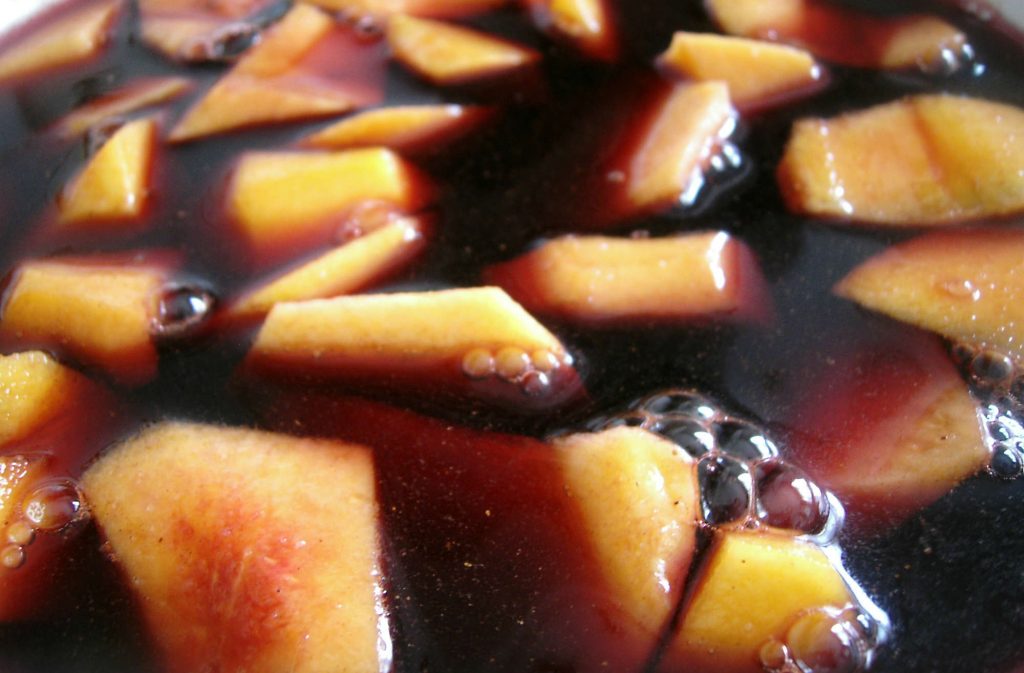
Peach with wine is a quintessential Zaragozan dessert that combines the aroma of peaches and the sweetness of Aragon’s wines.
The sweetness of the juicy peaches from Calanda, known for their exceptional quality and unparalleled flavor, is the city’s best tribute to its lands and traditions.
Preparation of Peaches with Wine
Preparing this dessert is a ritual full of tradition that begins with selecting the ripest and most perfect peaches. Later, they are peeled and immersed in an excellent quality red wine, for its ability to complement and enhance the natural sweetness of the fruit.
Then, they are sugared and perfumed with a touch of cinnamon that fills them with an aroma that transports us to the warmth and richness of the Aragonese autumn.
Over time, the peaches will take on the wine, never dissolving into it, becoming a culinary creation that is as much a dessert as it is a sensory experience. In it, the texture of the fruit, ennobled by maceration, combines with the complex flavor of the wine to move from sweetness to body in a balance that is not only technical but also emotional.
Every sip or spoonful offers a dessert that is both refreshing and comforting.
Identity and Flavor in a Unique Dessert
Peach with wine is much more than a delicious mix; it’s a delicacy that embodies the cultural identity of Zaragoza and pays homage to an important aspect of the region: the perfect blend between viticulture and agriculture.
This dessert is not only a manifestation of the harvest season and a way to enjoy the fruit of the Calanda peaches in all their glory but also a journey to the past evocative of the wine tradition in Aragon, the importance of wine in social life and in Aragonese gastronomy.
Peach with wine does not need to be served on special occasions to be enjoyed: it is rather the occasion itself, and the perfect context in which Zaragozans and tourists can remember and celebrate the beauty and generosity of Aragonese nature, celebrated in every bite of this delight that tastes of flavor, tradition, and culture.
Torrijas: A Humble but Authentic Dessert

Within the rich gastronomy of Zaragoza, a simple yet deeply traditional sweet stands out: torrijas.
This dessert, a star of Holy Week, has modest origins but a long history dating back centuries, when it was devised as a way to repurpose and give a second life to day-old bread.
Torrijas are not only delicious to the palate but also part of a tradition passed down from generation to generation, evoking the history and culture of Aragon.
Preparation of Torrijas
The making of torrijas begins with preferably day-old bread, so its texture can better absorb the milk or wine, depending on the variant, without falling apart.
This bread is cut into slices, which are then soaked in milk flavored with cinnamon and lemon peel to infuse subtle but deep flavors and aromas.
After soaking well, they are dipped in beaten egg and fried in hot oil until perfectly golden. The final touch is a generous layer of sugar and cinnamon sprinkled over the still warm torrijas, creating a crunchy texture that contrasts nicely with the soft and spongy interior.
Beyond their preparation, torrijas demonstrate the Aragonese culinary ability to transform simple ingredients into extraordinary dishes.
Their origins trace back to the Middle Ages when they were already mentioned in the recipe book as a way to utilize leftover bread.
Over the centuries, they have become a symbol of Holy Week not only in Zaragoza but throughout Spain, adapting and evolving with each generation while maintaining their comforting essence and unmistakable flavor.
Getting to know Zaragoza also means exploring its flavors, and torrijas are a must-stop on this sensory journey.
More than just a dessert, they represent the living history of Aragon, a history that is savored bite by bite.
Tasting them is not only to enjoy an exquisite sweet but also to partake in a tradition that endures over time, uniting people around the table in celebration of faith, family, and community.
A Gastronomic Journey Through Zaragoza
The gastronomy of Zaragoza is a faithful reflection of its history, culture, and geographical environment, where dishes range from very simple ones with deep traditional roots to innovative and creative culinary proposals that respect and enhance local raw materials.
Every bite, every tasting of these dishes, and every sip of their sweets, nourishes both the body and spirit, telling centuries-old stories and celebrating the rich diversity of Zaragoza. So, the next time you visit the capital of Aragon, be sure to take a sensory tour that promises to be as enriching as it is unforgettable.
Enjoy your meal, and have a great gastronomic journey through Zaragoza!
You can also go a step further and encourage yourself to take one of our private tours through the center of Zaragoza, and if you liked these proposals for Dishes of Zaragoza, you cannot miss our selection of 10 things to do if you visit Zaragoza.

